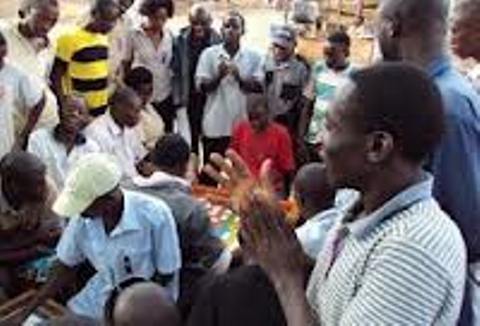HIV Prevention for South African Youth: Which Interventions Work? A Systematic Review of Current Evidence

Brown University (Harrison), Africa Centre for Health and Population Studies, University of KwaZulu Natal (Newell, Imrie, Hoddinott), Africa Centre for Health and Population Studies, University of KwaZulu Natal (Newell), National Centre in HIV Social Research, University of New South Wales (Imrie)
"In countries where HIV prevalence has declined at population level, sexual behaviour change among young people has been cited as an important contributing factor. Yet, questions remain regarding how to achieve - and maintain - the individual-level behavioural changes needed to reduce HIV incidence."
This review assesses the evidence base for youth HIV prevention among youth aged 12-24 years in South Africa. It addresses study design, intervention design including content and theoretical basis, thematic focus and HIV causal pathways, and intervention delivery and implementation. [Footnotes are removed throughout by the editor.] "Comprehensive sexuality education is considered an important means of addressing adolescent risk behaviours....Recent trials of youth HIV prevention interventions have achieved mixed results. Three large community trials of comprehensive approaches to youth HIV prevention, involving schools and other key institutions and stakeholders, have failed to significantly reduce HIV incidence in young people, and have shown only modest success in increasing protective behaviours. However, two group-based interventions in South Africa have shown promise in reducing reported HIV-related risk behaviours, and in one case, associated biological outcomes. Both interventions addressed HIV-related structural factors, or the social influences underlying HIV risk, namely gender-based violence and women's poverty. Together with limited results of several smaller, school-based interventions, these outcomes have triggered debate about 'which interventions work'."
Eight youth HIV prevention intervention studies were selected. Informal interviews were conducted with at least one researcher from each selected intervention, and requests were made for copies of project materials. "The process was further informed by a… scientific workshop convened to discuss … issues related to schools and youth HIV prevention research." The categories of analysis included: "1) process of intervention development, including formative research; 2) cultural/linguistic adaptation; 3) use of social/behavioural theory; 4) how and where the intervention was delivered (e.g., classroom, community, after school, extra periods); 5) who delivered the intervention (e.g., peer educators, teachers, trained facilitators); 6) selection and reinforcement of key messages; 7) involvement of participants and/or broader community; 8) focus on social context and risk environments, as well as individual risk behaviours; and 9) focus on HIV causal pathways of relevance to South African setting."
The interventions varied in thematic focus, hypothesised causal pathways, theoretical basis, delivery method, intensity, and duration. "Interventions were school- or group-based, involving in- and out-of-school youth. Primary outcomes included HIV incidence and reported sexual risk behavior alone or with alcohol use. Interventions led to reductions in sexually transmitted infection (STI) incidence and reported sexual or alcohol risk behaviours, although effect size varied. All but one targeted at least one structural factor associated with HIV infection: gender and sexual coercion, alcohol/substance use, or economic factors. Delivery methods and formats varied, and included teachers, peer educators, and older mentors. School-based interventions experienced frequent implementation challenges."
As stated here: "...[G]iven the range of interventions that have been tested, differences in the relative strengths and weaknesses of evaluation designs, and the limited effectiveness of many interventions, a definitive assessment of 'what works' is not possible. Yet important lessons are learned, leading to specific recommendations for future research." Recommendations derived from the comparison of interventions include:
- "An important feature - and the [interventions’] area of greatest impact - was the focus on HIV causal pathways relevant to southern Africa, namely gender, sexual coercion, alcohol use and economic risk”;
- A focus is needed on the structural and institutional context - “[For example, the] HealthWise intervention offered young people alternatives for leisure time use, while in the Adolescent Livelihoods project young people learned life skills, such as numeracy, that may enhance vocational and educational success. Promising economic interventions are also being tested in other sub-Saharan African settings”;
- Work to change social norms showed promise - "Stepping Stones' success was clearly associated with altering beliefs about gender and HIV risk, particularly among men, and with offering viable alternative normative behaviours. One way that group intervention approaches, such as IMAGE and Stepping Stones, generate positive social norms is through engaging participants in collective critical thinking, thereby fostering self-esteem and individual empowerment. Community mobilisation, employed effectively among women in the IMAGE project and in other promising interventions, is also an important component"; and
- There was evidence of a need to engage schools in new ways, including participatory learning - "Importantly, most school-based interventions do not use a group approach, but are delivered didactically by teachers in classrooms, relying on the ability of students to act individually on information received. A simple way to address this would be for school-based interventions to include more group-based, rather than didactic, learning.... While peer education is popular among students, this review supports other findings that offer little evidence for its ability to increase intervention impact. One approach with certain advantages over teachers, who often resist teaching sexuality education, and same-age peers, who may sometimes have difficulty commanding the necessary authority to run a classroom, would be to use older youth as 'mentors'. School mentors could work in partnership with teachers who request to teach sexuality education and HIV prevention, but would relieve the reliance on teachers who do not want this responsibility."
Bio Med Central Public Health 2010 website, 10:102, accessed May 6 2013.
- Log in to post comments
